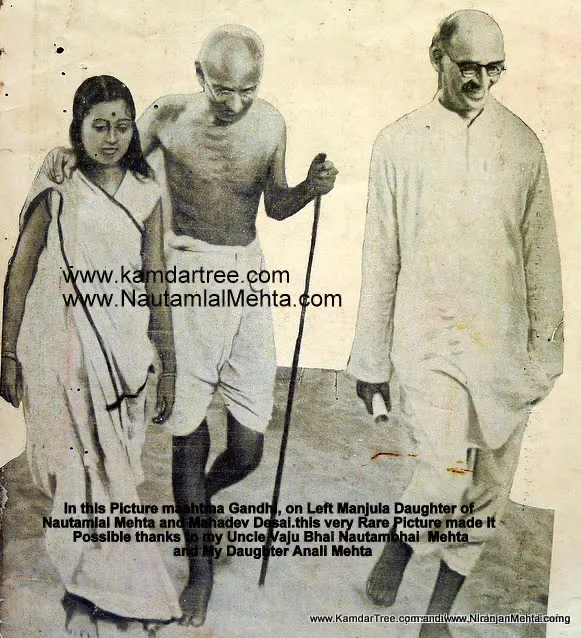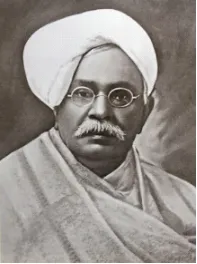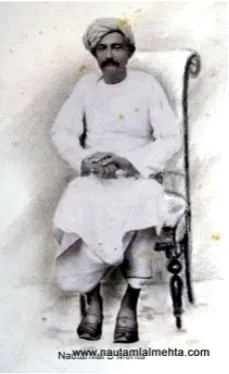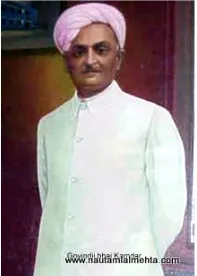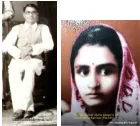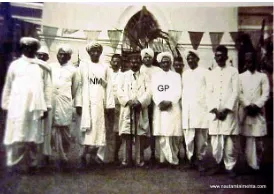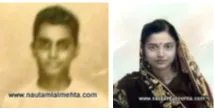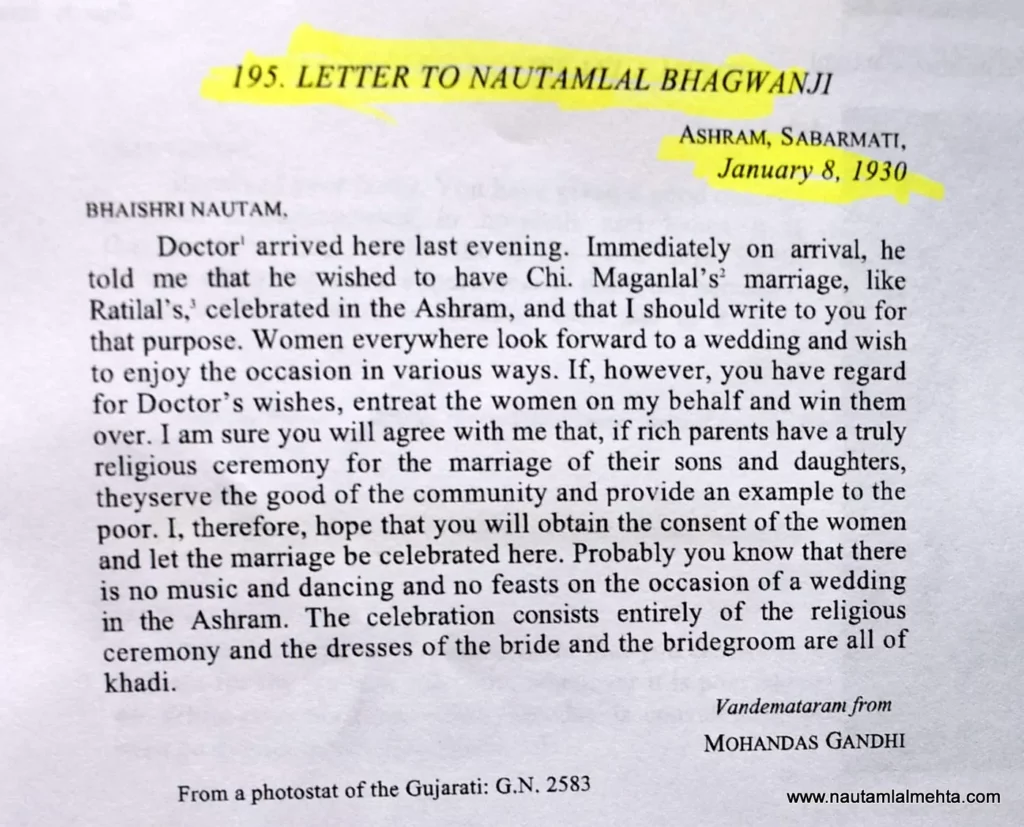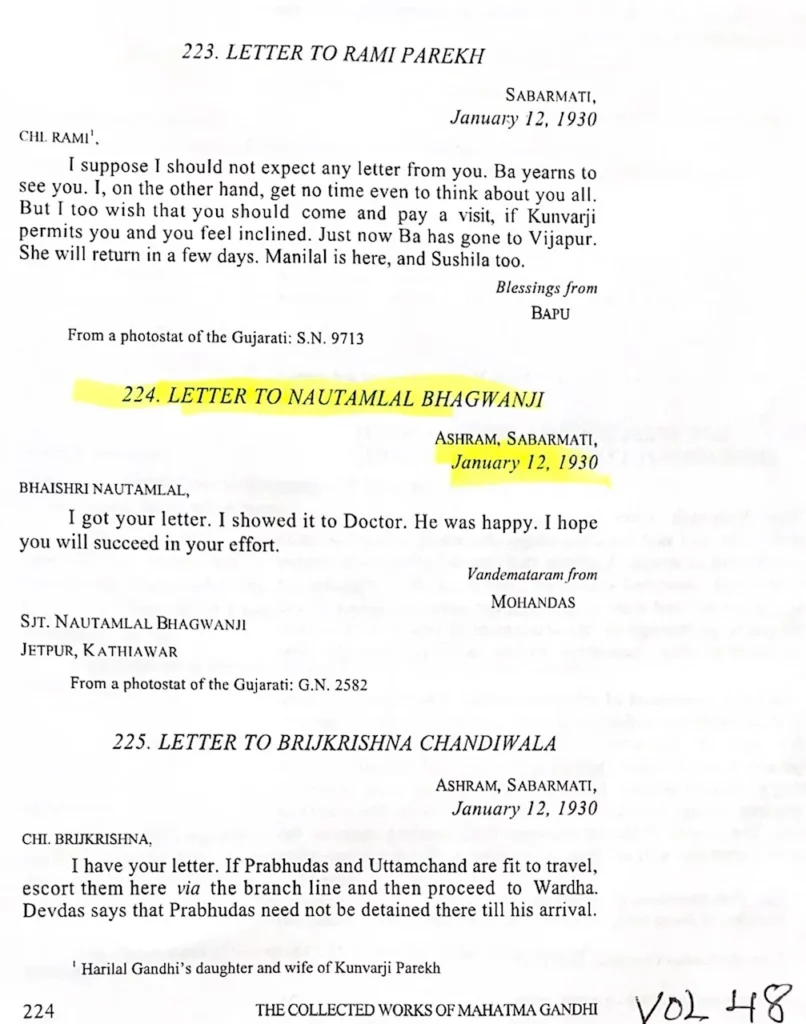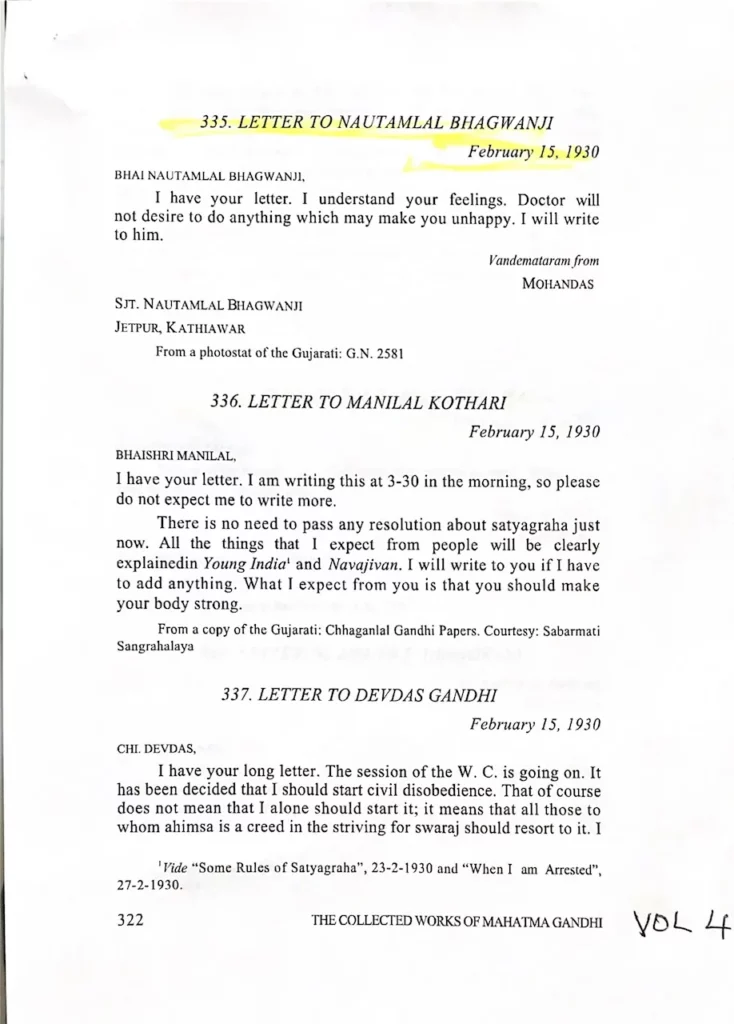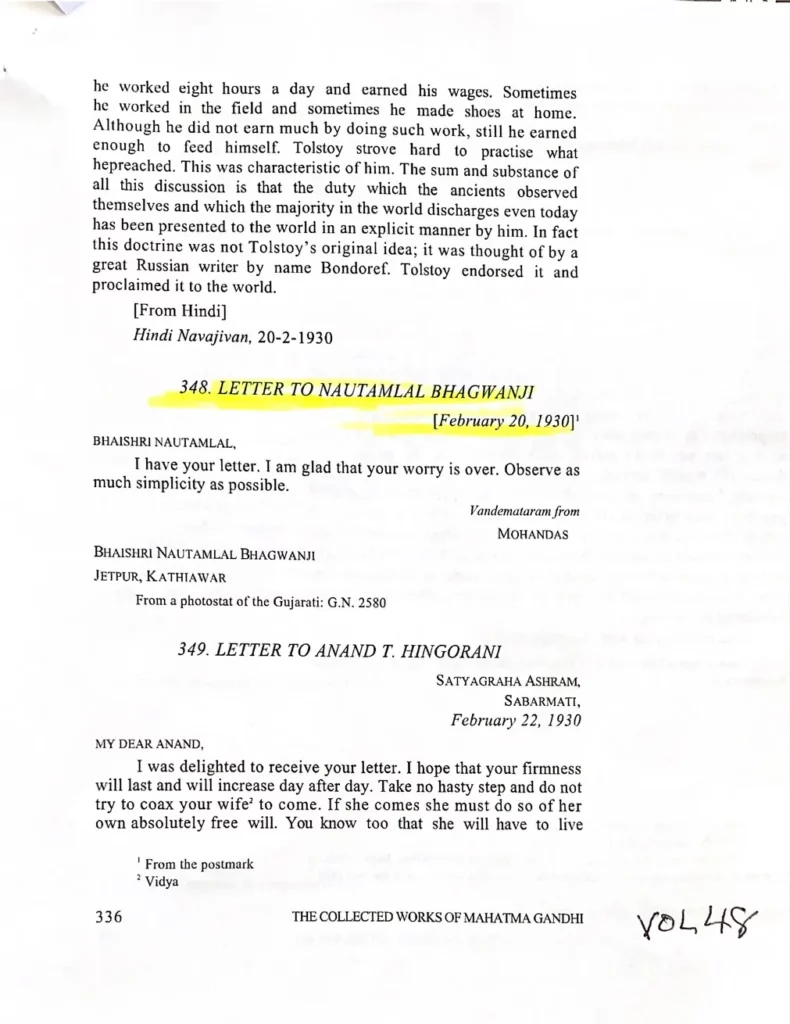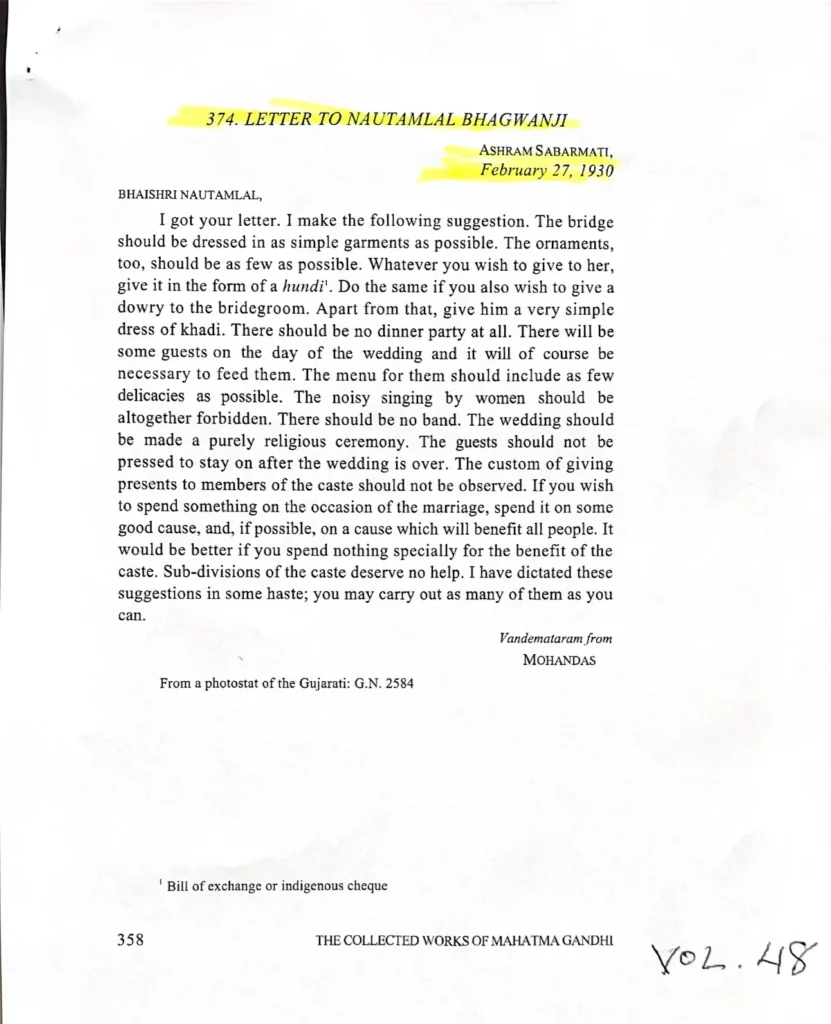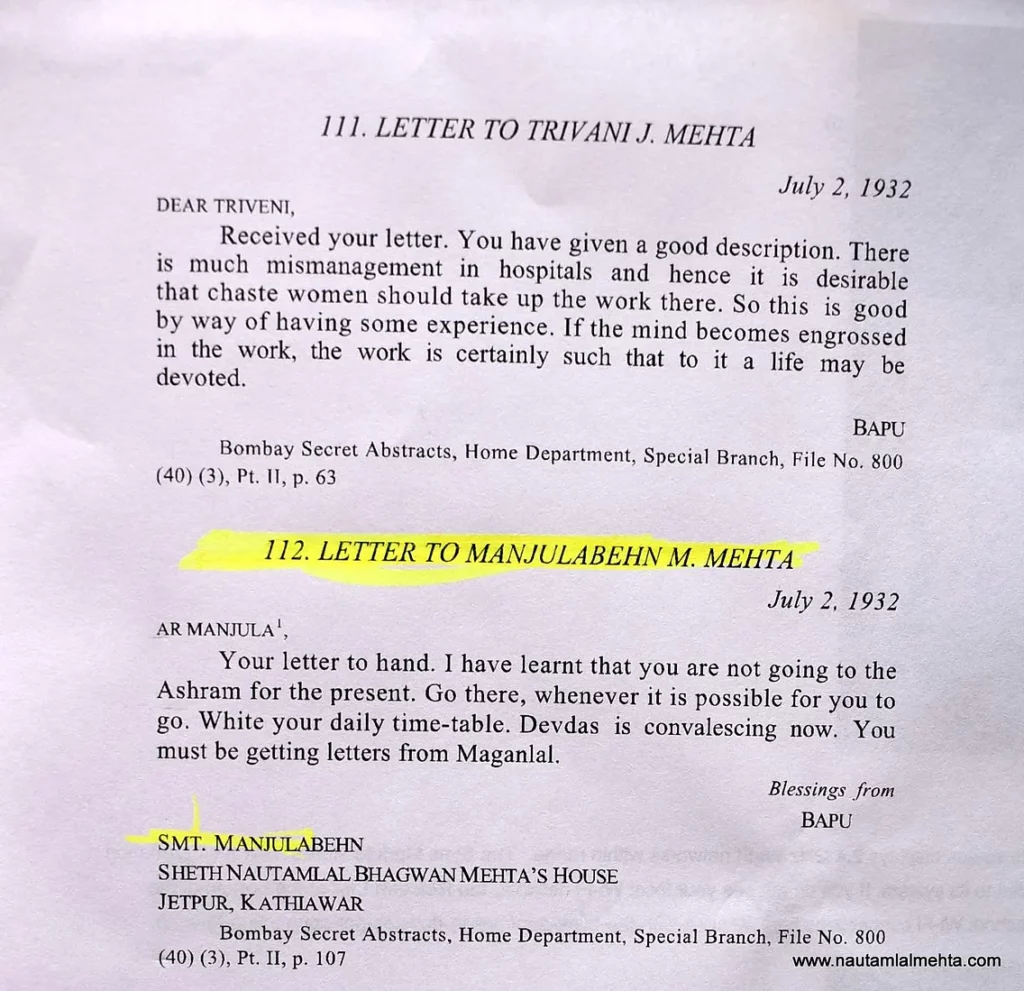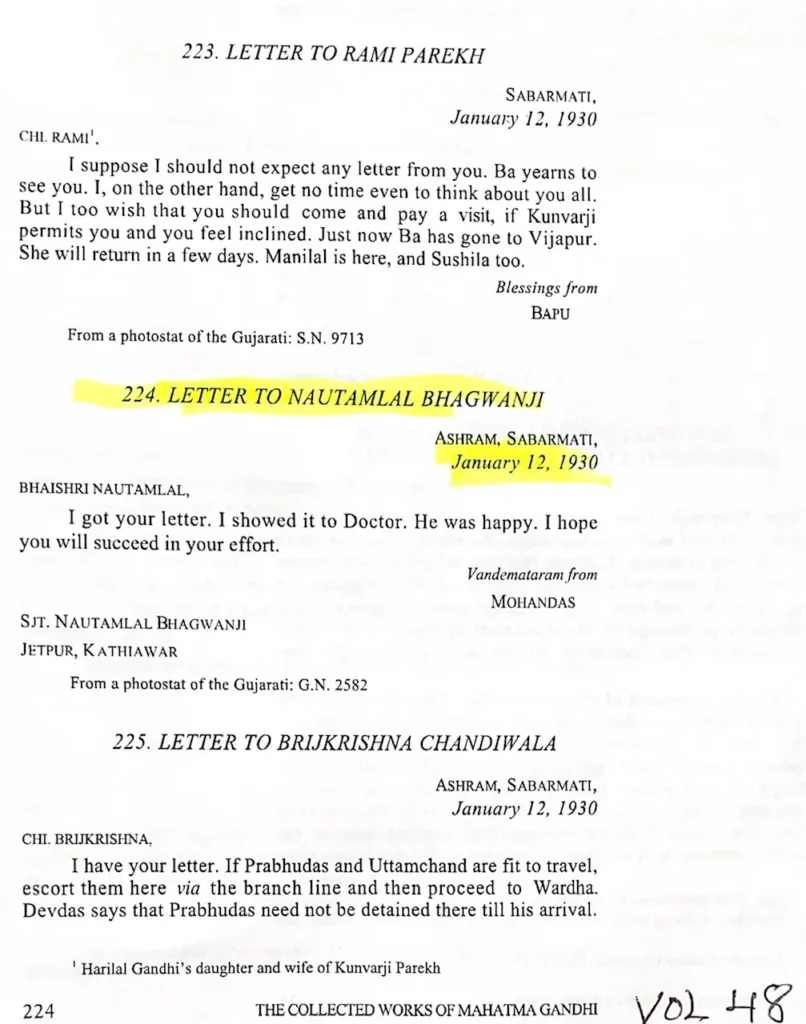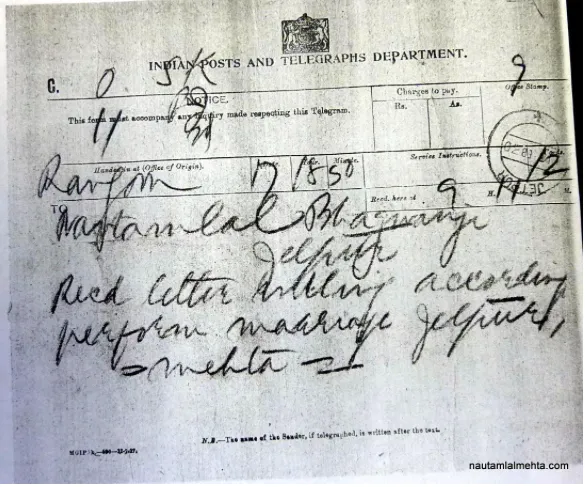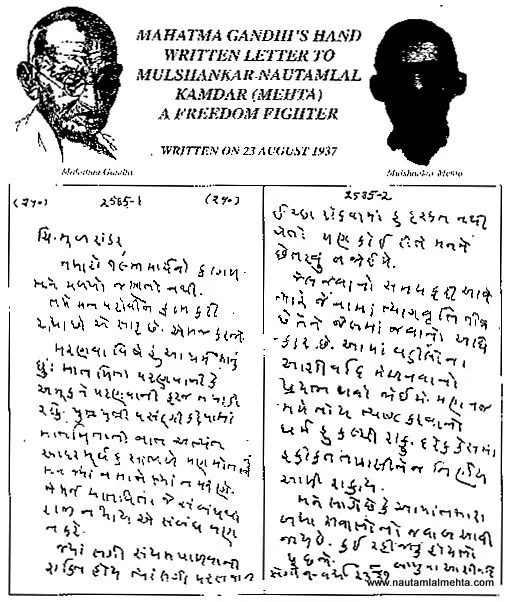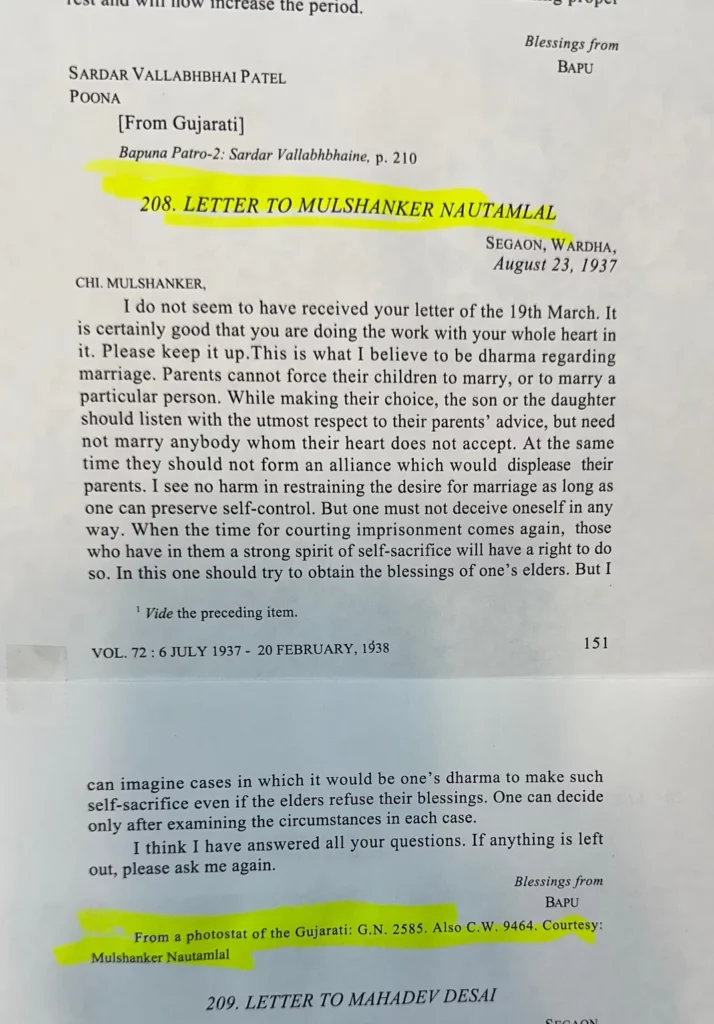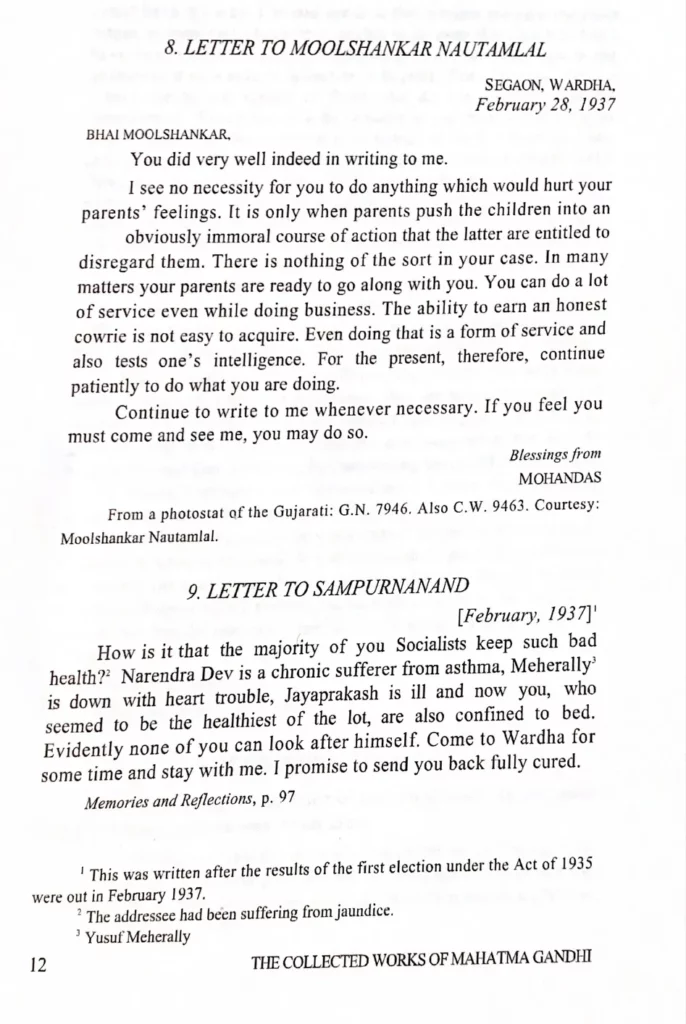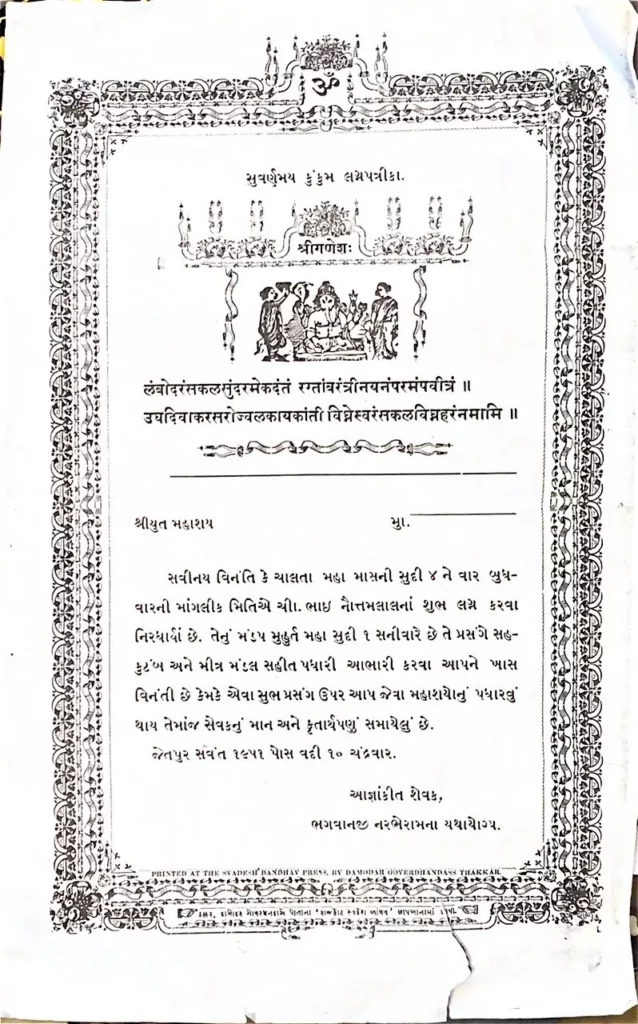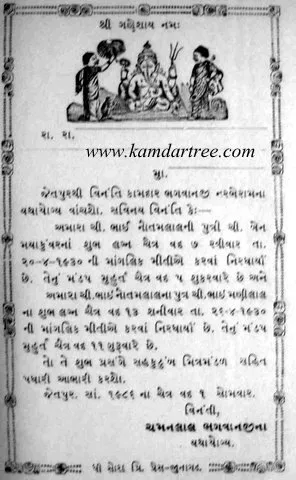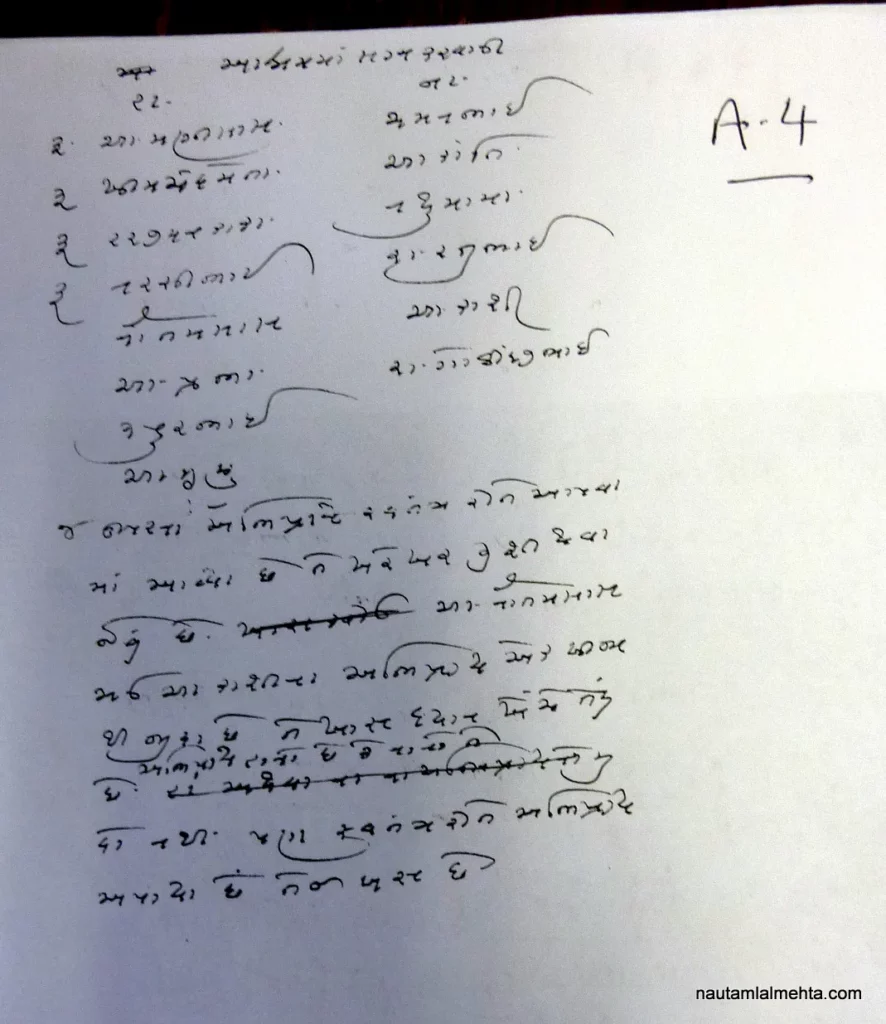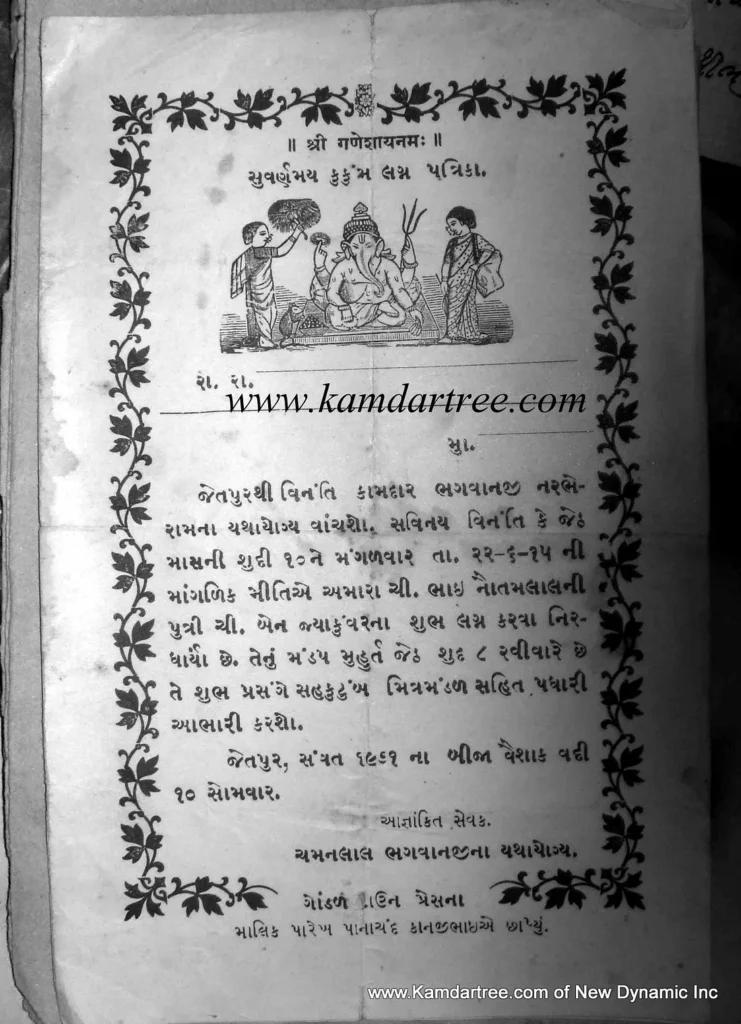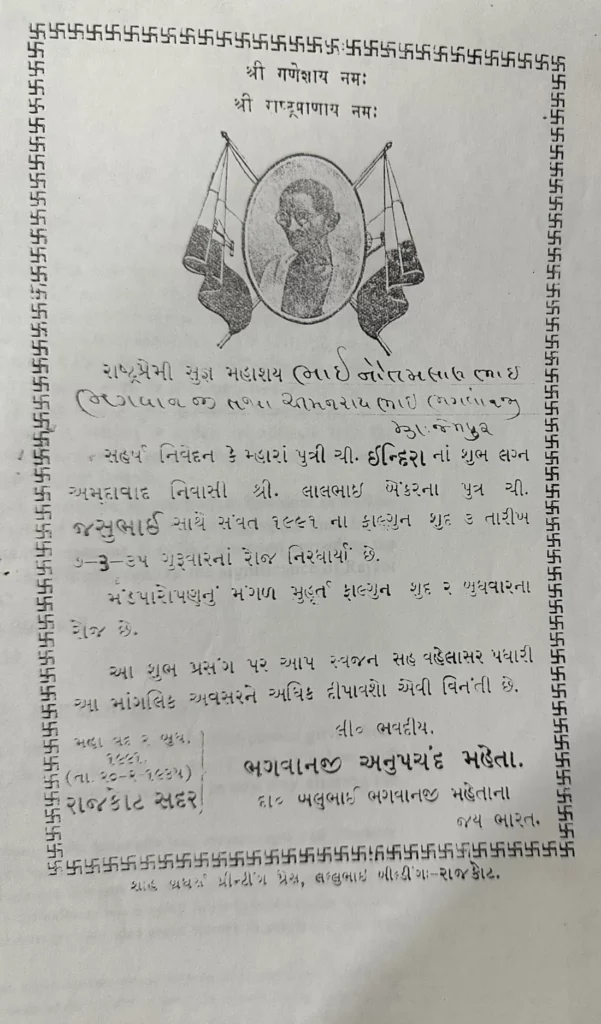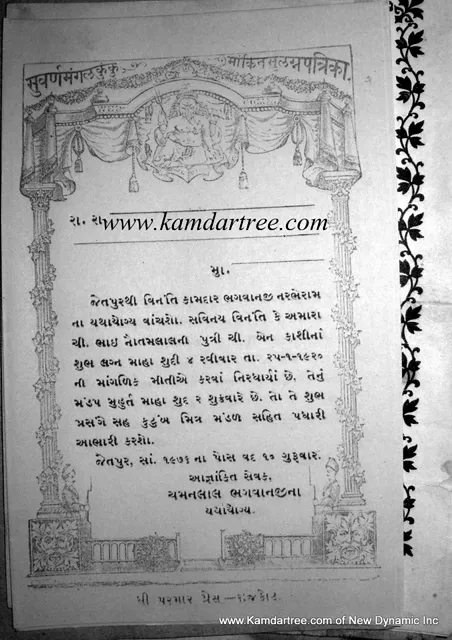This May be the Only website in the World where you will see More Documents, Proof, and evidence, Very Little or NO subjective or creative writing because Our documents speak for themselves.
Note: We could have Hired a Book writer, a film Producer, or a journalist very comfortably to make more Drama with lots of publicity. But it is not in our background. It is never needed because every document speaks for itself with a few lines. It is a matter of your sense, your logic. And Judgment. I don’t want our golden truth to be populated.
The information is on Nautamlal Mehtas’s daughter Manjula ( Maya) and Nautamlal Mehtas’s Son Manilal. Both marriages were organized within a week’s frame. Mahatma Gandhi wanted both marriages to be held at the Sabarmati asharam
The Daughter of Nautamlal Bhagawanji Mehta Manjula ( Maya) Mahatma Gandhis Used to treat her as his favorite daughter; she is with Mahatma Gandhi and Mahadev Desai.
Millions upheld Mahatma Gandhiji’s tenets throughout
the World. Perhaps one such example where Gandhiji’s values
were contested and kept in the story involving the wedding of
my parents, Manilal Nautamlal Mehta and Sharda (nee Pushpa)
Govindji Kamdar (Mehta), and that of my aunt (faiba) Manjula Nautamlal Mehta and Maganlal Pranjivan Mehta.
Top: Dr. P.J. Mehta, Nautamlal B. Mehta, and Govindji Kamdar. Bottom: Manilal Mehta and Sharda Kamdar, Nautamlal B. Mehta and Govindji Kamdar at Manilal and Sharda’s wedding, April 1930, and Maganlal Mehta and Manjula Mehta
Dr Means DR Pranjiwan J Mehta January 8 1930
Before the above letter from Mahatma Gandhi To My Grand father, Nautamlal B Mehta, both marriages of Nautamlal B Mehta’s son Manilal and daughter Manjula were performed in a very traditional Hindu way. However, this letter made a great complexity in Nautamlals Family. For 50% of the family, it was impossible to arrange marriage in Sabarmati Ashram especially 100 years back, then Marriage is a spiritual and auspicious moment. Beyond their imagination
Letters from Mahatma Gandhi on both marriages of Nautamlal B Mehta’s children, Manilal and Manjula, were to be performed in a very traditional Hindu-Jain way. However, these correspondences created great complexity in Nautamlal’s close family. For 50% of the family, it was impossible to arrange marriage at Sabarmati Ashram because they were not comfortable skipping the auspiciousness and celebration of the unions. Even a boycott from the Jain Samaj (community) would make marriages for his remaining children and his brother’s children complicated. This situation forced Nautamlal to write a letter requesting that both his children’s marriages not be performed in the Ashram. These letters were Mahatma’s response.
Left: Mahatma’s letter after Dr. P.J. Mehta agreed with Nautamlal B Mehta that both marriages will not be performed in the Sabarmati Ashram but simply without fanfare or display of richness. Right: This is a critical letter from Mahatma, who wrote to Nautamlal Bhagawanji Mehta on arranging matters. Mahatma was the central hub between Nautamlalalal B Mehta and Dr. Pranjivan J Mehta while they were deciding whether to host the Marriage at Sabarmati Asharam.
Another story regarding marital decisions, involves Nautamlalbhai’s son,
Moolshankar Mehta. Moolshankar obtained a science degree from Fergusson College in Pune, India. He could have joined the successful family business on Princess Street, in Mumbai, but his desh bhakti and commitment towards the Freedom Movement spurred him away from a more traditional marital decisions, even though his parents wished for him to marry. Instead, he chose to own only two pairs of clothes, and stopped wearing any footwear, and dedicated his life to the Indian Freedom Movement and serving the down-trodden. This decision not
to marry was not made lightly. He even consulted Mahatma Gandhi in making this life decision. As a towering personality, his life story is often forgotten in the history of extraordinary individuals who made incredible sacrifices to advance the future of India with Gandhian values and spirit.
The information below is about Nautamlal Son Moolshankar, who never wanted to marry his Parents were expecting him to marry and still work for the freedom of India like thousands of Gandhian followers. this was the communication between. Of many letters, Moolshankar and Mahatma Gandhi. Here a few for the public. Ultimately, Moolshankar Never Married and gave his whole life to underprivileged people in 1993
In This Letter, Nautamlal’s 2nd son, Moolshankar, decided to do “Desh Seva” not to marry and Not to join his father’s business. Moolshankar’s Mother and family wanted him to settle down and Do desh Seva like other business people. In this letter, Gandhiji guides him on what he should do.
Manilalbhai and Manjulaben are siblings, and their father, Nautamlal B. Mehta, was a staunch Gandhian, as was Maganlalbhai’s father, Dr. Pranjivan J. Mehta (a barrister and a person Mahatma Gandhi once described as his “greatest friend and benefactor”). Amid all that Gandhiji was involved in during the 1930s, he still made time to guide Dr. P.J. Mehta and my grandfather, Nautamlal Mehta, through several letters regarding the Marriage of their children.
My grandfather, Nautamlal B. Mehta, was the Nagar Seth (a prominent
businessman) of Jetpur, Gujarat, not only agreed with Gandhiji ideologically but also donated substantial financial resources to the Indian Freedom Movement, which resulted in the family, over time, transitioning from millionaires to becoming less affluent. Yet, his respect for Gandhiji and desh bhakti (devotion to the nation) and the broader values never wavered. He was also the first to bestow the title “Mahatma” upon Gandhiji on January 15, 1921, in Jetpur, Gujarat. Dr. P.J. Mehta was also one of Gandhi’s earliest supporters and benefactors and significantly developed the salt satyagraha.
The marriages between Manilalbhai and Shardaben and Manjulaben and
Maganlalbhai were to occur in 1930 in a traditional Jain-Hindu ceremony. But before the wedding, Dr. P.J. Mehta requested that Gandhiji request that Nautamlalbhai consider the Marriage of Maganlalbhai and Manjulaben within Gandhi’s Sabarmati Ashram (earlier, Dr. P.J. Mehta’s other son Ratilal’s Marriage was performed at the Sabarmati Ashram). Gandhiji wrote a letter to Nautamlalbhai Mehta about Dr. P.J. Mehta’s request to have their two children marry within the Sabarmati Ashram, dated January 8, 1930, in which he says, “I am sure you will agree with me that, if wealthy parents have a genuinely religious ceremony for the Marriage of their sons and daughters, they serve the good of the community and provide an example to the poor…probably you know that there is no music and dancing and no feasts on the occasion of a wedding in the
Ashram. The celebration consists entirely of the religious ceremony, and the dresses of the bride and the bridegroom are all khadi.”
Nautamlalbhai was joyful about the idea and conveyed his enthusiasm and approval in another letter. Nautamlalbhai became so committed to the idea that he also wished for his son, Manilalbhai’s Marriage to Shardaben to occur within the
Ashram, under Gandhiji’s presence.
However, this idea could have sat better with Shardaben’s father, Govindji Kamdar. Govindbhai was the Divan of Gondal and did not want to upset the Maharaja of Gondal (almost all local rulers did not support the Gandhian freedom movement at the time and instead supported the British). Similarly, the majority of Nautamlalbhai’s extended family were opposed to the idea, and the broader Jain community (samaj) threatened to boycott Nautamlalbhai’s business, as well as any marriage proposal of his remaining children, if he proceeded with marriages in the Ashram. This reaction created a severe dilemma for Nautamlalbhai, who had to engage in a three-month diplomatic effort among decision-makers within his community, such as Ravishankarbhai Mehta (Jhaveri), Ratilal Motilal Sheth, Kapurbhai Choksy, and of course, Mahatma Gandhi.
On one hand, Nautamlalbhai had to contend with his strong Gandhian values and those of the family his daughter was marrying. Still, he also had to contend with the less-staunch Gandhian values of his extended family, the larger Stanakvasi Jain samaj, and the family his son was marrying. Weddings of that era, nearly 100 years ago, were multi-day affairs. But through several letters, telegrams, and leading a vote among family members, Nautamlalbhai, along with the assistance of Ravishankarbhai Mehta (Jhaveri) and Ratilal Motilal Sheth, ultimately negotiated with all parties and settled on both weddings occurring straightforwardly. After all, the threat of the Jain samaj boycott, Nautamlalbhai thought, would jeopardize the future marriage prospects
of seven other children within the extended family (Prabhaben, Vaniben,
Chamanbhai’s two daughters and three sons). In the end, Manilalbhai and
Shardaben’s wedding took place in the town of Muli (as Govindjibhai Kamdar was the Divan of Muli states) on April 26, 1930, and Manjulaben and Maganlalbhai were married in Jetpur on April 20, 1930.
Neither wedding took place in the Sabarmati Ashram, but elements of the
Gandhian wedding traditions were still incorporated — for instance, it was a very simple affair, and there was no menu display (dowry). There was no exchange of other vyahar (gifts between families). Gandhiji also wrote to Nautamlalbhai on February 27, 1930, with the following suggestions: “The wedding should be made a purely religious ceremony. The guests should not be pressed to stay on after the wedding. The custom of giving presents to caste members should not be observed. If you wish to spend something on the occasion of the Marriage, spend it on some good cause and, if possible, on a cause that will benefit everyone. Please spend nothing specifically for the benefit of the caste. Sub-divisions of the caste deserve no help.”
Gandhiji had encouraged all wedding party members to wear khadi, but my mother, Shardaben, pleaded with her mother, noting that “I am very thin-framed. How will I be able to handle the weight of heavy khaki? I will not be able to stand.” Khadi fabric 100 years ago was much coarser than now and weighed much more. My grandfather, Nautamlalbhai, addressed my mother’s concerns and arranged for a few kadhi silk weavers from Andra Pradesh to come to Jetpur to weave light-weight khadi silk sarees for Shardaben for her wedding. Although there was no display of any wild richness,
Govindjibhai still invested resources in his daughter’s name (without her knowing), which played a crucial role in 1949, when Manilalbhai and Shardaben returned to Rajkot, Gujarat, from war-torn Burma, after facing the loot of their rice mill in Pyapon, seven years earlier in March 1942. My father, Manilalbhai, and his immediate family had lost everything during
the Freedom Movement as they were deeply committed to the boycott of British goods. My grandfather, Nautamlalbhai, eventually had to surrender his 400+-year-old family wealth (pedhi) to the Indian central bank at the beginning of the war in 1939. Amid a profoundly principled alignment with Gandhiji’s principles and morals, along with an incredible financial sacrifice, Nautamlalbhai was able to find solutions to several problems that balanced the needs and desires of several conflicting beliefs
held by critical family members and the broader community
Nautamlalbhai had to contend with his own Gandhian solid values, as well as those of the family his daughter was marrying, on one side, but he also had to contend with the less-staunch Gandhian values of his extended family, the larger Stanakvasi Jain samaj, and the family his son was marrying. Weddings of that era, nearly 100 years ago, were multi-day affairs. But through several letters, telegrams, and leading a vote among family members, Nautamlalbhai, along with the assistance of Ravishankarbhai Mehta (Jhaveri) and Ratilal Motilal Sheth, ultimately negotiated with all parties and settled on both weddings occurring in a very simple manner. After all, the threat of the Jain samaj boycott, Nautamlalbhai thought, would jeopardize the future marriage prospects
of seven other children within the extended family (Prabhaben, Vaniben,
Chamanbhai’s two daughters and three sons). In the end, Manilalbhai and
Shardaben’s wedding took place in the town of Muli (as Govindjibhai Kamdar was the Divan of Muli states) on April 26, 1930, and Manjulaben and Maganlalbhai were married in Jetpur on April 20, 1930.
Neither wedding took place in the Sabarmati Ashram, but elements of the
Gandhian wedding traditions were still incorporated — for instance, it was a very simple affair, and there was no display of the “Aanu “(dowry). There was no exchange of other vyahar (gifts between families). Gandhiji also wrote to Nautamlalbhai on February 27, 1930, with the following suggestions: “The wedding should be made a purely religious ceremony. The guests should not be pressed to stay on after the wedding. The custom of giving presents to caste members should not be observed. If you wish to spend something on the occasion of the Marriage, spend it on some good cause, and, if possible, on a cause that will benefit all people. Please spend nothing specifically for the benefit of the caste. Sub-divisions of the caste deserve no help.”
Gandhiji had encouraged all wedding party members to wear khadi, but my mother, Shardaben, pleaded with her mother, noting that “I am very thin-framed. How will I be able to handle the weight of heavy khadi? I will not be able to stand.” Khadi fabric 100 years ago was much coarser than now and weighed much more. My grandfather, Nautamlalbhai, addressed my mother’s concerns and arranged for a few kadhi silk weavers from Andra Pradesh to come to Jetpur to weave light-weight khadi silk sarees for Shardaben, for her wedding. Although there was no display of an “aanu,” 9 a daughter share in fathers property or for many, it can be dowry) Govindjibhai still invested resources in his daughter’s name (without her knowing), which played a crucial role in 1949, when Manilalbhai and Shardaben returned to Rajkot, Gujarat, from war-torn Burma, after facing the loot of their rice mill in Pyapon, 7 years earlier in March 1942. My father, Manilalbhai and his immediate family had lost everything during
the Freedom Movement as they were deeply committed to the boycott of British goods. My grandfather, Nautamlalbhai, eventually had to surrender his 550+-year-old family wealth (pedhi) to the Indian central bank at the beginning of the war in 1939. Amid a deeply principled alignment with Gandhiji’s principles and morals, along with an incredible financial sacrifice, Nautamlalbhai was able to find solutions to several problems that balanced the needs and desires of several conflicting beliefs held by vital family members and the broader community.
Khadi wearing started in Nautamlal bhai’s home as early as 1916–1919, probably Pioneer Khadi-wearing family in Saurashtra.
Additional Nautamlal Mehta’s Family Marriage Interesting Stories
My grandfather, Nautamlal B. Mehta’s other children, Prabhaben and
Moolshankarbhai also had interesting marital stories.
Prabhaben’s Marriage was arranged before her birth to a similarly unborn
Kantibhai, the son of Kapurbhai Nathalal Choksy of Junagadh. Prabhaben and Kantibhai’s mothers were pregnant around the same time, and both
Nautamlalbhai and Kapurbhai had known each other’s families for several
generations. At the time, among some Hindu and Jain families, it was not
uncommon to arrange marriages between families who had known each other for a very long time, even for their unborn children. To proceed with such a ceremony required immense trust and understanding between the two families.
This practice is referred to as pet chandla. The ceremony usually involves a puja led by a priest who applies a red dot on the stomach of both pregnant mothers. Assuming that each mother delivers a child from a different sex from the other mother, then their children’s Marriage would proceed when the children were of age. Thus, although the engagement between Prabhaben and Kantibhai was arranged before either one was born, their Marriage was performed in their early 20s (see photos below).
Kantibhai became a very accomplished violinist. The famous K.L. Saigal respected him greatly. When Kantibhai was experiencing difficult health issues later in life, K.L. Saigal came from Mumbai to sing for Kantibhai to boost his spirits.
Nautamlal Bhagavanji Mehtas’s Daughter, Prabha Ben, Married Kantilal Kapurbhai Choksy of Junagadh. Even before birth, she and Kanti Bhai’s Marriage was committed between Kamdar-Mehta and the Choksy family. In Saurashtra, we call “Pete Chandala,” when two families have known each other for generations and both confidently know their future children. They make this kind of rare decision very Happily and willingly
Almost 130 years ago, this was the Marriage of the Kankotri “invitation of Nautamlal Bhagawanji Mehta. How simple, without any drama, even The name of the Bride and Her family details.

